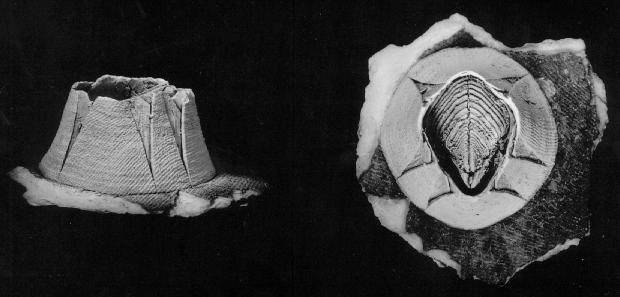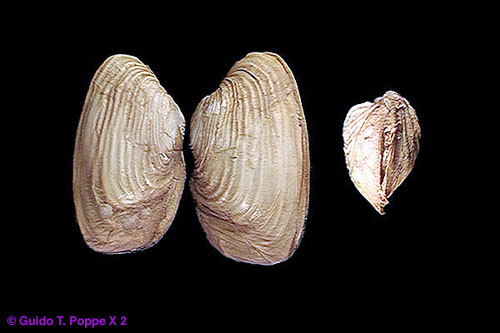MARINE LIFE
Macrofossil Assemblages
![]()
The marine macrofossil assemblages of the Champlain Sea consists primarily of bryozoans, cirripeds, sponges and bivalves, whereas fresh water assemblages consist of mostly gastropods and bivalves. Although the one species of brachiopod found in Champlain Sea sediments, Hemithyris psittacea, has stenohaline tendencies, its fossils were found in the eastern extremity of the Champlain Sea, therefore it must have tolerated slight dilutions.
The most abundant invertebrate found in fossiliferous Champlain Sea deposits, marine and freshwater alike, are bivalves. There are eight important marine fossil associations, groups of fossil assemblages named after the dominant species in the assemblage, and one important fresh water association.
The following table shows the names of the dominant macrofossil assemblage that characterize each association present in Champlain Sea sediments, their ages and some of their characteristics. Ages for all macrofossils are based on C14 dating methods, except for the Mytilus edulis, whose age was inferred from the presence of associations at sites where other species have been dated.
Macrofaunal Associations
Assemblage
|
Class |
Photograph |
Time Range |
Species Characteristics |
|
Balanus hameri (Marine) |
Arthropoda |
 |
11.3 ö 11.1 |
Lives in deeper. more saline and cooler waters |
|
Hiatella
ar (Marine) |
Bivalvia |
 |
11.4 ö 10.1 |
Adapted several times to diluted waters |
|
Macoma balthica (Marine) |
Bivalvia |
 |
12.2 ö 10.75 |
Often found in biocoenosis with Mya
arenaria
Lived at shallower depths |
|
Macoma calcarea (Marine) |
Bivalvia |
|
~ 10.6 (only date published) |
Preferred deeper waters |
|
Mya arenaria (Marine) |
Bivalvia |
 |
11.1 ö 10.5 |
Common to shoreline deposits
Thermophilic nature and extremely low δ18O values indicate shallow water habitat. |
|
Mya truncata (Marine) |
Bivalvia |
 |
~ 10.3 (only date published) |
Lived
in typical seawater salinity levels, and therefore greater depths
*See section on salinity for more about the relationship between salinity and depth |
|
Mytilus edulis (Marine) |
Bivalvia |
 |
11.2 ö 10.8 |
Adapted well to low salinity levels
and temperatures
Confined to relatively diluted surface waters |
|
Portlandia arctica
(Marine) |
Bivalvia |
 |
12.15 ö 10.75 ka ±100 y |
Common to silty clay environments
found along glacier fronts
Lived in more shallow and less saline conditions |
|
Lampsilis (Fresh water) |
Bivalvia |
 |
10.25 ö 9.75 |
![]()